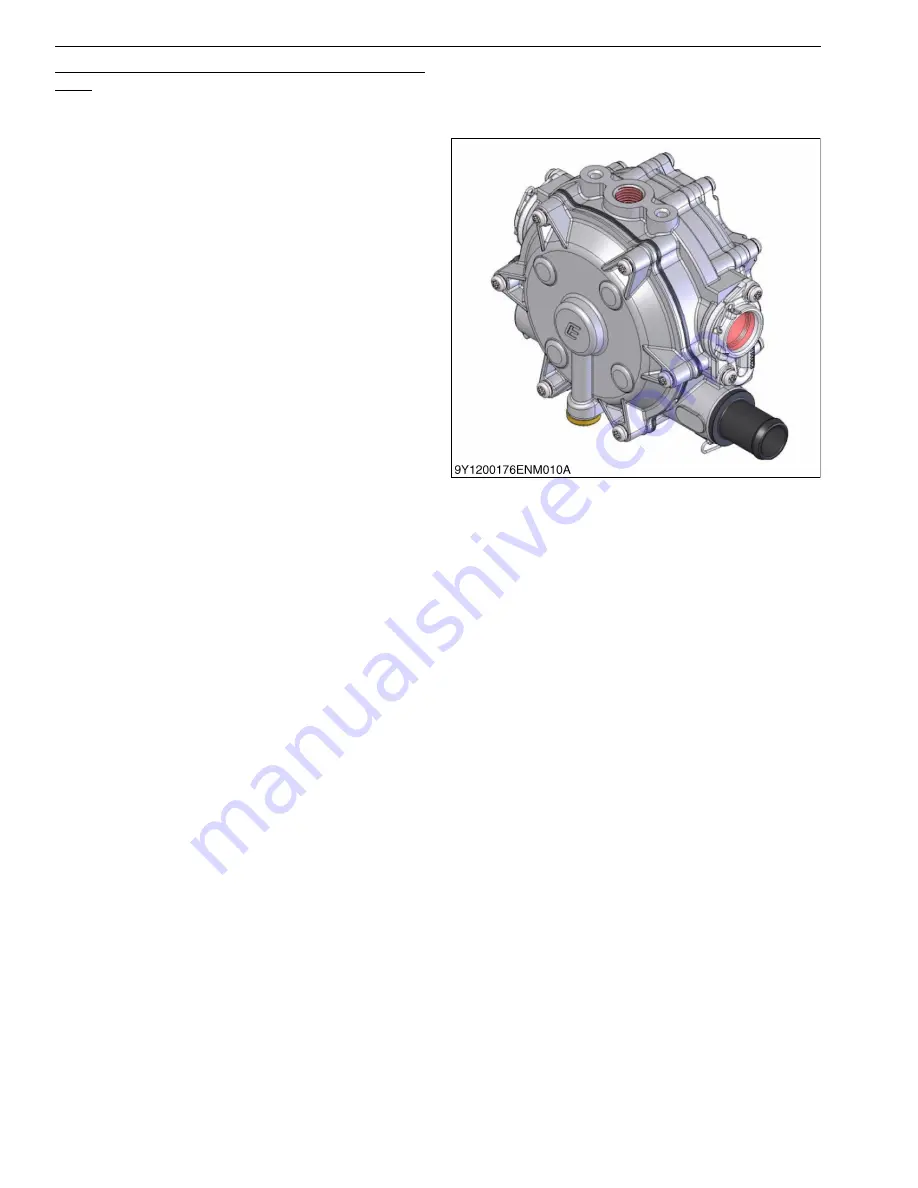
ECM SYSTEM
WG1605-G-E3,WG1605-L-E3,WG1605-GL-E3, DM
1-48
DUAL STAGE REGULATOR (DSR) (L, N, GL, LN,
GLN)
The DSR is a combination vaporizer, pressure
regulating device. The DSR is a two stage regulator that
is normally closed, when the engine is not running. When
the engine is cranking or running, a partial vacuum is
created in the fuel line, which connects the regulator to
the Direct Electronic Pressure Regulators (DEPR), and
mixer. This partial vacuum opens the second stage
regulator, permitting fuel to flow to the DEPR, and mixer.
LPG / natural gas fuel enters the primary port of the
DSR, and passes through the primary jet, and into the
primary/exchanger chamber. As the LPG / natural gas
passes through the heat exchanger, the fuel expands,
and creates pressure inside the chamber. The pressure
rises as the fuel expands, when the pressure rises above
10 kPa (0.11 kgf/cm
2
, 1.5 psi); sufficient pressure is
exerted on the primary diaphragm, to cause the
diaphragm plate to pivot, and press against the primary
valve pin, thus closing off the flow of fuel. This action
causes the flow of fuel, into the regulator to be regulated.
When the engine is cranking, sufficient vacuum will be
introduce into the secondary chamber, from the
EPR/mixer, drawing the secondary diaphragm down
onto the spring loaded lever, and opening the secondary
valve, allowing vaporized fuel, to pass to the mixer.
Increased vacuum, in the secondary chamber, increases
the downward action on the secondary lever, causing it
to open wider, allowing more fuel to flow to the mixer.
The DSR requires a connection to the engine
coolant, to prevent freezing in the regulator, during the
pressure reduction phase, within the regulator. Coolant
connections on the DSR are fitted with "Push In" fittings.
These fitting are designed with an o-ring seal, which
allows the fitting to be pushed into the water connection
on the DSR, and are then lock by spring locks, and
retained by screws.
The DSR is connected to the DEPR, by a low
pressure flexible hose. Like the other fuel hoses used in
the fuel system, the low pressure hose is designed with
a special inner core, and is usually wire reinforced, to
prevent collapse of the hose, during high demand fueling
operations. The low pressure hose should only be
replaced, with the recommended
Kubota
hose
replacement.
The packaging of the regulator, into the engine and
chassis, must be approved by Kubota, to insure
continued long term operation, of the fuel delivery and
emission control system. You should never relocate the
regulator, or any of the fuel system components, as
doing so, may cause excess build up of oil in the
regulator, improper coolant flow, or improper fuel
delivery.
In certain regions, fuel supplies may be made up of
much different chemicals and during the heating of the
fuel, in the heat exchange section of the regulator,
"heavy end" or petroleum oils, may accumulate over
time. To drain the DSR, remove the fuel outlet hose and
pour the oils out of the regulator. To determine the
frequency, for draining the regulators, refer to the
Recommended Maintenance Schedule.
The regulator utilized on USA emission certified
engines, are a critical part of the certified emissions
system, and does not require any periodic adjustment.
Figure 14:
Dual Stage Regulator (DSR)
KiSC issued 12, 2016 A
Содержание WG1605-E3
Страница 1: ...WG1605 E3 DIAGNOSIS MANUAL ECM SYSTEM KiSC issued 12 2016 A...
Страница 3: ...I INFORMATION KiSC issued 12 2016 A...
Страница 4: ...CONTENTS 1 SAFETY FIRST I 1 INFORMATION KiSC issued 12 2016 A...
Страница 8: ...1 ECM SYSTEM KiSC issued 12 2016 A...
Страница 10: ...23 Spark Coil Primary DTC 2300 2301 2303 2304 2306 2307 2309 2310 1 228 KiSC issued 12 2016 A...






























